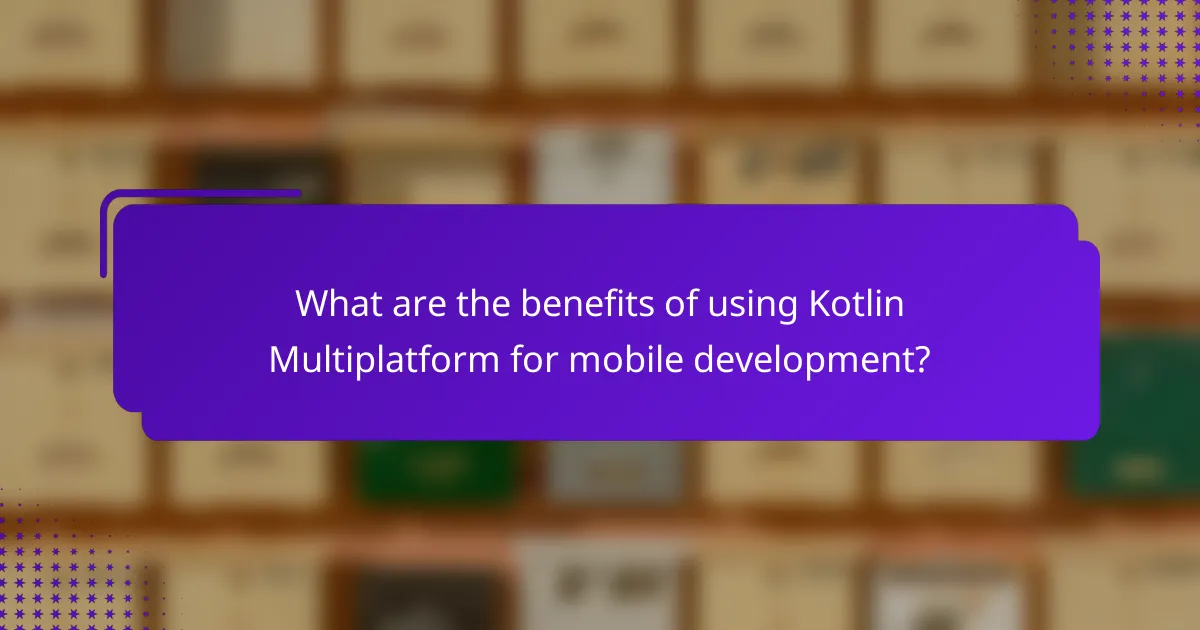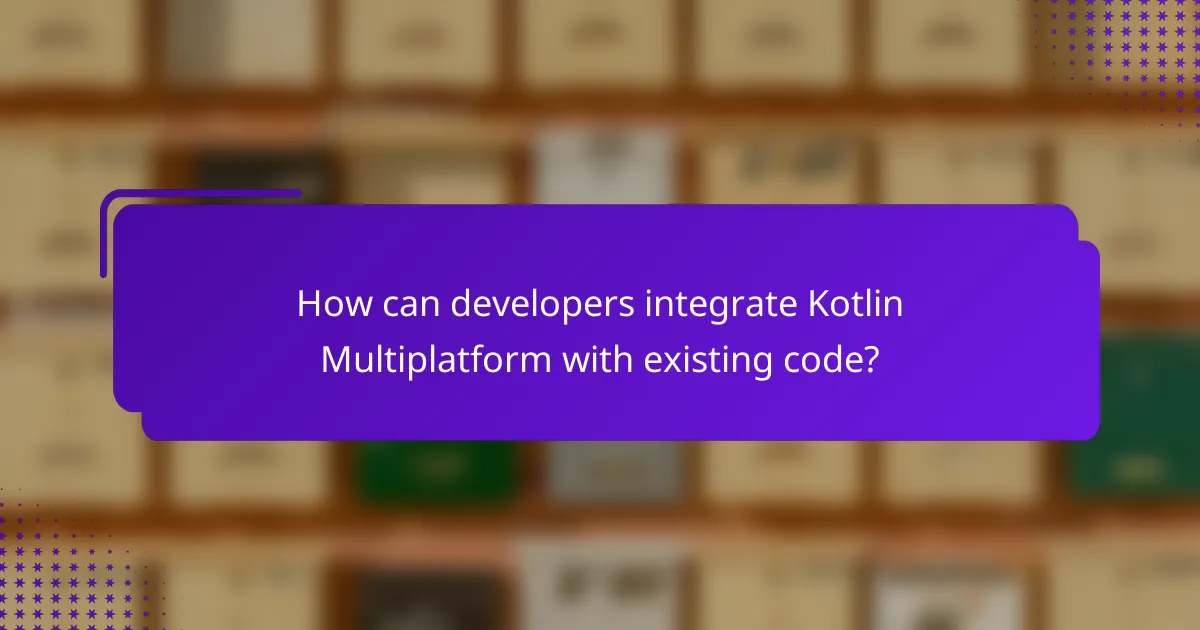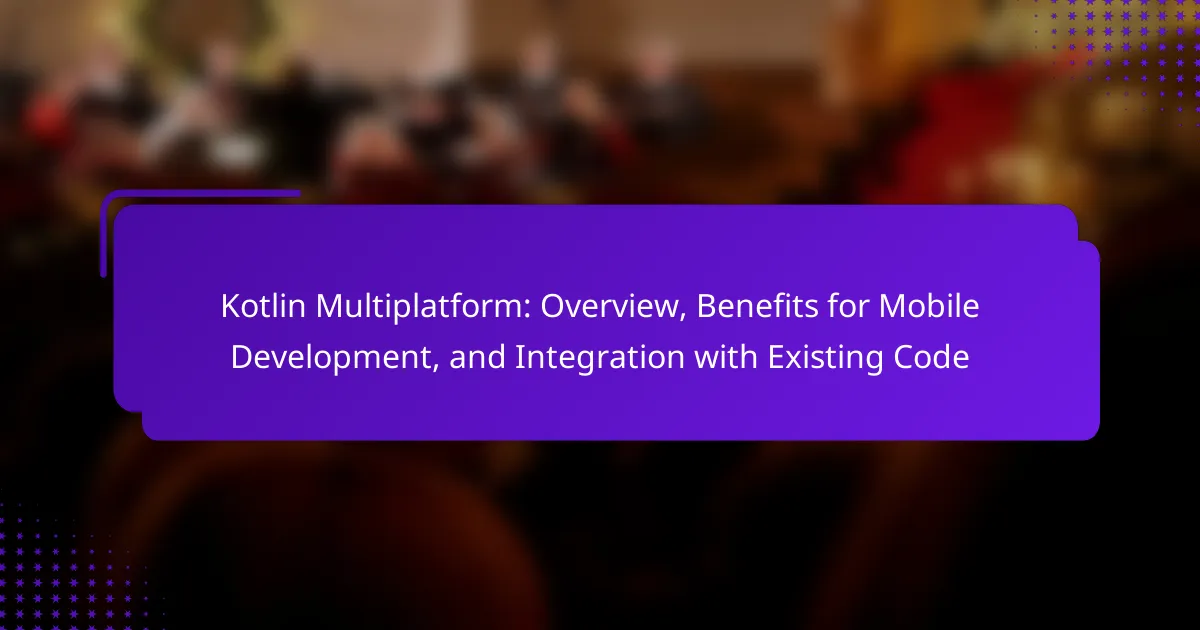Kotlin Multiplatform is a cross-platform development technology that allows developers to share a single codebase across Android, iOS, web, and desktop applications. This approach enhances efficiency by reducing duplicate code while enabling platform-specific implementations when necessary. The article outlines the significant benefits of Kotlin Multiplatform for mobile development, including improved consistency in app functionality and user experience, as well as support for native performance. Additionally, it provides a structured method for integrating Kotlin Multiplatform with existing code, detailing steps for identifying shared code, setting up projects, and ensuring compatibility across platforms.

What is Kotlin Multiplatform?
Kotlin Multiplatform is a technology that allows developers to share code across multiple platforms. It enables the use of a single codebase for applications targeting Android, iOS, web, and desktop. Kotlin Multiplatform leverages the Kotlin programming language’s features for cross-platform development. This approach reduces the need for duplicate code, streamlining the development process. It allows for platform-specific implementations when necessary. Developers can write shared code in Kotlin while using native APIs for each platform. Kotlin Multiplatform is backed by JetBrains, the creators of Kotlin. It is designed to improve efficiency in mobile and cross-platform application development.
How does Kotlin Multiplatform enable cross-platform development?
Kotlin Multiplatform enables cross-platform development by allowing developers to write shared code that can run on multiple platforms. This shared code can include business logic, data models, and other non-UI components. Developers can write platform-specific code when necessary, ensuring that the application can leverage unique features of each platform. Kotlin Multiplatform supports Android, iOS, web, and desktop applications, promoting code reuse. The technology uses Kotlin’s language features, such as coroutines and extension functions, to simplify development. By facilitating a single codebase, Kotlin Multiplatform reduces maintenance overhead and accelerates development cycles. This approach has been adopted by various organizations, demonstrating its effectiveness in real-world applications.
What are the key features of Kotlin Multiplatform?
Kotlin Multiplatform enables code sharing across platforms. It supports Android, iOS, web, and backend development. Developers can write common code once and reuse it. This reduces duplication and accelerates development. Kotlin Multiplatform allows for platform-specific implementations when needed. It integrates smoothly with existing codebases. Developers can leverage libraries from different ecosystems. This flexibility enhances collaboration among teams. Overall, Kotlin Multiplatform streamlines cross-platform development effectively.
How does Kotlin Multiplatform differ from traditional development methods?
Kotlin Multiplatform allows developers to share code across multiple platforms, unlike traditional methods that typically require separate codebases. This approach reduces redundancy and accelerates development time. Traditional development often involves writing platform-specific code for iOS and Android, leading to increased maintenance efforts. Kotlin Multiplatform enables the use of shared business logic, which can be written once and reused. This results in fewer bugs and a more consistent user experience across platforms. Additionally, Kotlin Multiplatform integrates seamlessly with existing codebases, allowing gradual adoption without needing a complete rewrite. This flexibility is a significant advantage over traditional methods.
What are the core components of Kotlin Multiplatform?
The core components of Kotlin Multiplatform include Kotlin/JVM, Kotlin/JS, and Kotlin/Native. Kotlin/JVM enables developers to write applications that run on the Java Virtual Machine. Kotlin/JS allows for the development of applications that compile to JavaScript, enabling web functionality. Kotlin/Native facilitates the creation of applications for iOS and other platforms without the need for a virtual machine. These components work together to allow code sharing across different platforms, enhancing development efficiency. Kotlin Multiplatform supports shared codebases, which reduces duplication and maintenance efforts. This structure promotes a unified development experience across mobile and web applications.
What roles do shared code and platform-specific code play?
Shared code in Kotlin Multiplatform allows developers to write common logic once and reuse it across multiple platforms. This reduces duplication and ensures consistency in application behavior. Platform-specific code, on the other hand, enables developers to implement features that are unique to a specific platform, such as iOS or Android. This ensures optimal performance and user experience tailored to each platform’s capabilities.
For example, shared code can handle business logic while platform-specific code manages user interfaces. This separation allows teams to leverage the strengths of each platform while maintaining a unified codebase. Research shows that using shared code can speed up development time by up to 30% while still allowing for customization through platform-specific implementations.
How is the Kotlin Multiplatform architecture structured?
Kotlin Multiplatform architecture is structured around shared and platform-specific code. The shared code is written in Kotlin and can be used across multiple platforms like Android, iOS, and web. Platform-specific code is implemented using the native capabilities of each platform. This allows developers to leverage platform features while maintaining a common codebase. The architecture includes modules that define shared logic, which can be consumed by different applications. Kotlin Multiplatform uses expect/actual declarations to handle platform-specific implementations. This structure promotes code reuse and reduces duplication, enhancing development efficiency.

What are the benefits of using Kotlin Multiplatform for mobile development?
Kotlin Multiplatform offers significant benefits for mobile development. It enables code sharing across platforms, reducing development time and effort. This approach allows developers to maintain a single codebase for both Android and iOS apps. Kotlin Multiplatform also enhances consistency in app functionality and user experience across different devices.
Moreover, it supports native performance, ensuring that applications run efficiently on each platform. Kotlin’s interoperability with existing Java and Swift code allows seamless integration into current projects. This flexibility helps teams leverage their existing code while adopting modern development practices. Kotlin Multiplatform is backed by JetBrains, a reputable company in software development, ensuring ongoing support and improvements.
How does Kotlin Multiplatform enhance productivity for developers?
Kotlin Multiplatform enhances productivity for developers by enabling code sharing across platforms. Developers can write shared code once and use it on both Android and iOS. This reduces the amount of duplicate code, saving time and effort. The framework allows for faster iteration cycles. Developers can test and deploy features more quickly across multiple platforms. Kotlin’s interoperability with existing codebases further streamlines development. It allows teams to integrate Kotlin with Java and Swift seamlessly. This flexibility leads to improved collaboration among team members. Overall, Kotlin Multiplatform optimizes resources and accelerates project timelines.
What specific advantages does Kotlin Multiplatform offer in terms of code reuse?
Kotlin Multiplatform offers significant advantages in terms of code reuse by allowing developers to share common code across multiple platforms. This capability reduces duplication of effort when developing for iOS and Android. Shared code can include business logic, data models, and networking code. This leads to a more efficient development process and faster time-to-market. Furthermore, Kotlin Multiplatform enables seamless integration with existing native codebases. This means developers can leverage existing platform-specific features while maintaining shared code. As a result, teams can focus on writing and maintaining less code overall, which enhances productivity and reduces maintenance costs.
How does Kotlin Multiplatform improve app performance across platforms?
Kotlin Multiplatform improves app performance across platforms by enabling shared code across different environments. This approach reduces redundancy and minimizes the need for platform-specific implementations. Consequently, developers can write code once and reuse it, leading to faster development cycles. The shared code is optimized for each target platform, ensuring efficient execution. Additionally, Kotlin’s native capabilities allow for direct access to platform APIs, enhancing performance. The result is a more responsive app experience with lower resource consumption. Studies show that applications using Kotlin Multiplatform can achieve up to 30% faster load times compared to traditional methods.
What impact does Kotlin Multiplatform have on project timelines?
Kotlin Multiplatform can significantly reduce project timelines. It allows developers to share code across multiple platforms, minimizing duplication of effort. This shared codebase accelerates development for both Android and iOS applications. By using Kotlin Multiplatform, teams can streamline testing and maintenance processes. Consequently, this leads to faster iterations and quicker time-to-market. Research shows that companies utilizing Kotlin Multiplatform have reported up to 30% reduction in development time. This efficiency stems from the ability to write once and deploy across platforms.
How can Kotlin Multiplatform reduce development costs?
Kotlin Multiplatform can reduce development costs by enabling code sharing across platforms. This allows developers to write a single codebase for both Android and iOS applications. Consequently, it minimizes the need for separate teams to develop and maintain different codebases. According to JetBrains, using Kotlin Multiplatform can lead to a 30-50% reduction in development time and costs. This efficiency results from less duplication of effort and streamlined updates across platforms. Additionally, Kotlin’s interoperability with existing codebases reduces the expenses associated with transitioning from legacy systems. Overall, Kotlin Multiplatform provides a cost-effective solution for cross-platform mobile development.
What are the long-term benefits of adopting Kotlin Multiplatform?
Kotlin Multiplatform offers several long-term benefits for developers. It enables code sharing across platforms, reducing development time and effort. This leads to faster updates and feature releases. The shared codebase ensures consistency in functionality and user experience across different platforms. Kotlin Multiplatform also enhances maintainability, as updates can be made in one place. Furthermore, it allows teams to leverage existing Kotlin code, facilitating integration with current projects. The growing community and ecosystem around Kotlin Multiplatform provide ongoing support and resources. According to JetBrains, Kotlin’s creator, adoption rates are increasing, indicating a positive trend for long-term use.

How can developers integrate Kotlin Multiplatform with existing code?
Developers can integrate Kotlin Multiplatform with existing code by following a structured approach. First, they should identify the shared code that can be reused across platforms. This includes business logic and data models. Next, they need to create a Kotlin Multiplatform project using Gradle. This project structure allows them to define common code and platform-specific implementations.
After setting up the project, developers can gradually migrate existing code into the shared module. They should ensure that dependencies are compatible with Kotlin Multiplatform. Testing the shared code across different platforms is crucial to confirm functionality. Finally, developers can utilize Kotlin’s expect/actual mechanism to handle platform-specific features. This approach allows seamless integration into existing applications while maintaining code efficiency.
What strategies should developers use for seamless integration?
Developers should use modular architecture for seamless integration. This approach allows for independent components that can be developed, tested, and deployed separately. It simplifies the integration process by minimizing dependencies between modules. Developers should also utilize shared code to promote reuse across platforms. This reduces redundancy and ensures consistency in functionality. Continuous integration and deployment (CI/CD) practices are essential. They automate testing and deployment, catching issues early in the development cycle. Version control systems facilitate collaboration and manage code changes effectively. By maintaining clear documentation, developers can ease the onboarding process for new team members. These strategies enhance the overall integration experience in Kotlin Multiplatform projects.
How can Kotlin Multiplatform co-exist with existing native codebases?
Kotlin Multiplatform can co-exist with existing native codebases by leveraging shared code modules. Developers can create shared Kotlin code that integrates with platform-specific implementations. This allows for code reuse while maintaining native performance. The interoperability of Kotlin with Java and Objective-C facilitates this integration. Existing native code can call Kotlin code seamlessly. Conversely, Kotlin code can interact with native libraries. This dual capability ensures that teams can gradually adopt Kotlin Multiplatform without needing to rewrite entire codebases. The use of Gradle allows easy configuration for both shared and native code projects.
What tools and frameworks facilitate integration with Kotlin Multiplatform?
Kotlin Multiplatform integration is facilitated by various tools and frameworks. Gradle is a primary build tool that supports Kotlin Multiplatform projects. It allows for streamlined dependency management and project configuration. Ktor is a framework for building asynchronous servers and clients in connected applications. It simplifies networking tasks across platforms. Kotlinx.serialization is a library for serialization and deserialization of data classes. It ensures data consistency across different platforms. Additionally, Multiplatform Mobile (KMM) is a plugin that enhances mobile app development using Kotlin Multiplatform. It provides tools for sharing code between Android and iOS. These tools and frameworks collectively enhance the integration capabilities of Kotlin Multiplatform, promoting code reuse and efficiency.
What challenges might developers face during integration?
Developers might face several challenges during integration with Kotlin Multiplatform. One major challenge is compatibility issues with existing codebases. Legacy systems may not support Kotlin or have dependencies that conflict with Kotlin’s features. Another challenge is the learning curve associated with Kotlin Multiplatform. Developers familiar with other languages may struggle to adapt to Kotlin’s syntax and paradigms. Additionally, debugging can be complex due to the cross-platform nature of the code. This complexity may lead to longer development cycles and increased maintenance efforts. Finally, performance optimization can be a challenge, as different platforms may require tailored solutions to achieve optimal performance.
What are common pitfalls to avoid when integrating Kotlin Multiplatform?
Common pitfalls to avoid when integrating Kotlin Multiplatform include not properly managing dependencies. This can lead to version conflicts and compatibility issues. Another pitfall is neglecting platform-specific code. Each platform may require unique implementations, and ignoring this can result in runtime errors. Additionally, failing to test across all platforms can cause undetected bugs. Inconsistent code practices can also hinder collaboration among team members. Not leveraging shared code effectively may result in duplicated efforts. Lastly, overlooking documentation and community resources can limit understanding of best practices. These pitfalls can significantly impact the success of Kotlin Multiplatform integration.
How can developers troubleshoot integration issues effectively?
Developers can troubleshoot integration issues effectively by following a systematic approach. First, they should reproduce the issue in a controlled environment. This helps in isolating the problem. Next, they should review error logs for specific messages related to the integration failure. Analyzing these logs can reveal the underlying cause.
Additionally, developers should verify the compatibility of libraries and frameworks being used. Ensuring that all components are up to date can prevent many common issues. They should also check configurations and settings for discrepancies. Misconfigured settings often lead to integration problems.
Collaboration with team members can provide fresh perspectives on the issue. Pair programming or code reviews can uncover overlooked mistakes. Finally, consulting documentation and community forums can offer solutions from others who faced similar challenges. This methodical approach ensures that developers address integration issues thoroughly and efficiently.
What best practices should developers follow when using Kotlin Multiplatform?
Developers should follow several best practices when using Kotlin Multiplatform. First, they should structure the project to separate platform-specific code from shared code. This promotes clarity and maintainability. Second, developers should leverage common modules to encapsulate shared logic. This reduces code duplication and enhances reusability. Third, they should use expect/actual declarations to handle platform-specific implementations. This ensures compatibility across different platforms. Fourth, testing should be prioritized in shared code to catch issues early. This can be achieved through unit tests that run on multiple platforms. Fifth, developers should keep dependencies consistent across platforms. This minimizes version conflicts and integration issues. Lastly, they should stay updated with Kotlin Multiplatform’s evolving features and best practices. Regular updates ensure optimal use of the framework’s capabilities.
Kotlin Multiplatform is a technology that enables developers to share code across multiple platforms, including Android, iOS, web, and desktop, using a single codebase. This approach streamlines the development process by reducing code duplication and allowing for platform-specific implementations when necessary. The article explores the core components of Kotlin Multiplatform, its key features, and how it differs from traditional development methods. Additionally, it highlights the benefits of using Kotlin Multiplatform for mobile development, including improved productivity, reduced development costs, and enhanced app performance. Finally, it discusses strategies for integrating Kotlin Multiplatform with existing codebases and best practices for effective implementation.
